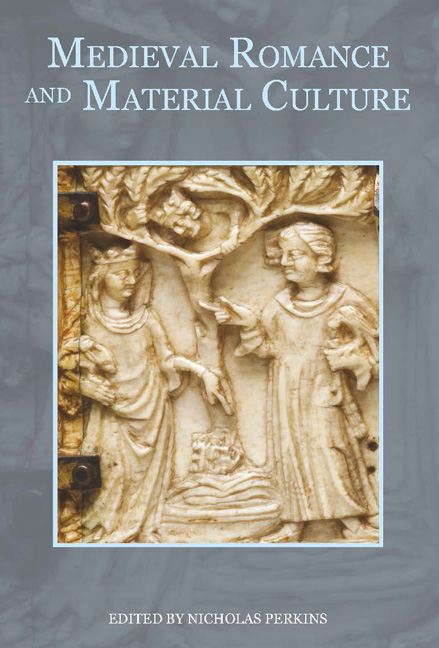37 results
Chapter 16 - Trouble and Strife in the Old French Fabliaux
- from IV - Genre and Gender
-
-
- Book:
- Women and Medieval Literary Culture
- Published online:
- 28 July 2023
- Print publication:
- 17 August 2023, pp 324-341
-
- Chapter
- Export citation
6 - ‘Vinegar upon Nitre’? Walter Map’s Romance of ‘Sadius and Galo’
-
-
- Book:
- Cultural Translations in Medieval Romance
- Published by:
- Boydell & Brewer
- Published online:
- 07 October 2022
- Print publication:
- 14 January 2022, pp 117-134
-
- Chapter
- Export citation
13 - Arthurian Literature in the Percy Folio Manuscript
-
-
- Book:
- Medieval Romance, Arthurian Literature
- Published by:
- Boydell & Brewer
- Published online:
- 20 December 2023
- Print publication:
- 15 October 2021, pp 189-204
-
- Chapter
- Export citation
7 - Treason
- from Part II - Literary Texts
-
-
- Book:
- The Cambridge Companion to Medieval English Law and Literature
- Published online:
- 26 July 2019
- Print publication:
- 08 August 2019, pp 83-94
-
- Chapter
- Export citation
8 - Gender Trouble? Fabliau and Debate in MS Digby 86
-
-
- Book:
- Interpreting MS Digby 86
- Published by:
- Boydell & Brewer
- Published online:
- 24 October 2019
- Print publication:
- 19 July 2019, pp 130-161
-
- Chapter
- Export citation
1 - Medieval Romance Mischief
- from I - Romance Disruptions
-
-
- Book:
- Romance Rewritten
- Published by:
- Boydell & Brewer
- Published online:
- 17 October 2019
- Print publication:
- 19 October 2018, pp 27-48
-
- Chapter
- Export citation
II - Who is the Traitor at the Beginning of Sir Gawain and the Green Knight?
-
-
- Book:
- Arthurian Literature
- Published by:
- Boydell & Brewer
- Published online:
- 17 July 2019
- Print publication:
- 20 July 2018, pp 22-51
-
- Chapter
- Export citation
Abbreviations
-
- Book:
- Medieval Romance and Material Culture
- Published by:
- Boydell & Brewer
- Published online:
- 05 May 2015
- Print publication:
- 16 April 2015, pp xiii-xiv
-
- Chapter
- Export citation
Contents
-
- Book:
- Medieval Romance and Material Culture
- Published by:
- Boydell & Brewer
- Published online:
- 05 May 2015
- Print publication:
- 16 April 2015, pp v-vi
-
- Chapter
- Export citation
Index
-
- Book:
- Medieval Romance and Material Culture
- Published by:
- Boydell & Brewer
- Published online:
- 05 May 2015
- Print publication:
- 16 April 2015, pp 275-285
-
- Chapter
- Export citation
Frontmatter
-
- Book:
- Medieval Romance and Material Culture
- Published by:
- Boydell & Brewer
- Published online:
- 05 May 2015
- Print publication:
- 16 April 2015, pp i-iv
-
- Chapter
- Export citation
List of Contributors
-
- Book:
- Medieval Romance and Material Culture
- Published by:
- Boydell & Brewer
- Published online:
- 05 May 2015
- Print publication:
- 16 April 2015, pp xi-xi
-
- Chapter
- Export citation
List of Illustrations
-
- Book:
- Medieval Romance and Material Culture
- Published by:
- Boydell & Brewer
- Published online:
- 05 May 2015
- Print publication:
- 16 April 2015, pp vii-x
-
- Chapter
- Export citation
5 - The Werewolf of Wicklow: Shapeshifting and Colonial Identity in the Lai de Melion
-
-
- Book:
- Medieval Romance and Material Culture
- Published by:
- Boydell & Brewer
- Published online:
- 05 May 2015
- Print publication:
- 16 April 2015, pp 75-90
-
- Chapter
- Export citation

Medieval Romance and Material Culture
-
- Published by:
- Boydell & Brewer
- Published online:
- 05 May 2015
- Print publication:
- 16 April 2015
Acknowledgements
-
- Book:
- Medieval Romance and Material Culture
- Published by:
- Boydell & Brewer
- Published online:
- 05 May 2015
- Print publication:
- 16 April 2015, pp xii-xii
-
- Chapter
- Export citation
Contents
-
- Book:
- Heroes and Anti-Heroes in Medieval Romance
- Published by:
- Boydell & Brewer
- Published online:
- 05 February 2013
- Print publication:
- 19 April 2012, pp v-vi
-
- Chapter
- Export citation
Notes on the Contributors
-
- Book:
- Heroes and Anti-Heroes in Medieval Romance
- Published by:
- Boydell & Brewer
- Published online:
- 05 February 2013
- Print publication:
- 19 April 2012, pp vii-viii
-
- Chapter
- Export citation
Introduction
-
-
- Book:
- Heroes and Anti-Heroes in Medieval Romance
- Published by:
- Boydell & Brewer
- Published online:
- 05 February 2013
- Print publication:
- 19 April 2012, pp 1-6
-
- Chapter
- Export citation
Abbreviations
-
- Book:
- Heroes and Anti-Heroes in Medieval Romance
- Published by:
- Boydell & Brewer
- Published online:
- 05 February 2013
- Print publication:
- 19 April 2012, pp ix-x
-
- Chapter
- Export citation



